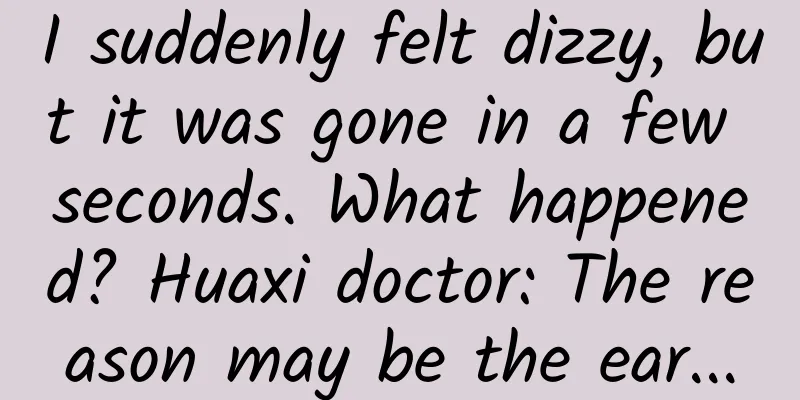I suddenly felt dizzy, but it was gone in a few seconds. What happened? Huaxi doctor: The reason may be the ear...

|
Have you ever experienced I got up from the bed and suddenly felt dizzy. The world was spinning, and it was hard to stand up Even nausea and vomiting Just slow down and everything will be fine. Repeatedly annoying Come, come, come! Learn about otolithiasis Otolithiasis, medically known as benign paroxysmal positional vertigo (BPPV), is the most common peripheral vestibular disease, with the main manifestation being "dizziness". Image source: Photo Network When we do some actions to change the head position, such as getting up, lying down, turning over in bed, lowering or raising the head, etc., we suddenly experience short-term dizziness and characteristic nystagmus. This dizziness usually lasts no more than 1 minute and can recover on its own after a while . Some people may also feel nausea and vomiting at the same time. The vertigo caused by otolithiasis is paroxysmal and may appear and disappear suddenly . After each dizziness, after a while, the body feels fine again, but after a while the vertigo will come back again, and it will recur over a period of time, as if one has drunk several kilograms of liquor and is drunk. When most people hear about otolithiasis, their first reaction is, what is earwax? Does cleaning the ears work? How can stones grow in the ears? It's not like I sleep in a quarry... Otolithiasis is not earwax, so cleaning your ears won’t work! Moreover, there are really stones in our ears. They are not thrown in by others, and they have nothing to do with the quarry. We are born with them! Image source: Photo Network The deepest part of our ears is the inner ear, which is composed of the cochlea, vestibule and three semicircular canals. The vestibule and semicircular canals are connected to help the human body regulate body balance. There are cystic spots on the utricle and saccule of the vestibule. In the otolith membrane covering its surface, there are many calcium carbonate crystals, which are "otoliths" . However, these stones are very small and can only be seen under a microscope. The cause and pathogenesis of otolithiasis have not yet been fully clarified, but most people currently believe that it is caused by degeneration of the otolith organ due to various reasons or trauma that causes the shedding of otolith particles . When otolith particles fall off, these "stones" will float in the inner ear like sand and dust. If they drift into the nearby semicircular canals, they will stimulate the semicircular canal hair cells and produce a severe feeling of vertigo. Otolithiasis usually occurs after the age of 40, and the incidence rate tends to increase with age. In addition, head trauma, genetics, insufficient blood supply to the inner ear, inner ear diseases, hyperlipidemia, hypertension, migraine, diabetes, excessive fatigue, lack of sleep, etc. may all lead to otolithiasis. Therefore, in our daily lives, we should pay attention to: ● Control ear diseases. If the patient suffers from otitis media, inner ear diseases, etc., go to the hospital for treatment in time; ● Avoid head trauma and strenuous head movement. For example, drivers should avoid sudden braking and head bumps. When sitting up in the morning or lying down at night, do not move too quickly. ● Avoid staying up late, excessive fatigue, and ensure adequate sleep and a regular work and rest schedule; ● Don’t often look down at your phone for a long time; ● Try not to sleep in a fixed position for a long time to prevent the otoliths from falling off due to long-term gravity. Generally speaking, otolithiasis can heal itself in 2 to 6 weeks , and it does not threaten life safety like myocardial infarction or cerebral infarction. But this feeling of "drinking too much" is really uncomfortable. Patients with otolithiasis can choose to go to the hospital for repositioning treatment . Doctors will give different repositioning methods according to different types of otolithiasis, so that the otoliths that have fallen into the semicircular canals can return to their original positions. Statement: This article is a medical-related educational popular science article. It does not involve specific treatment methods or medical behaviors and cannot replace hospital visits. Experts who reviewed this article References [1] Zhong Naichuan. Rethinking about benign paroxysmal positional vertigo[J]. Journal of Clinical Otolaryngology Head and Neck Surgery, 2001, 15(012):531-533. DOI:10.3969/j.issn.1001-1781.2001.12.001. [2] Editorial Board of Chinese Journal of Otorhinolaryngology Head and Neck Surgery, Chinese Society of Otorhinolaryngology Head and Neck Surgery. Guidelines for the diagnosis and treatment of benign paroxysmal positional vertigo (2017) [C]//Chinese Society of Integrated Traditional Chinese and Western Medicine. Chinese Society of Integrated Traditional Chinese and Western Medicine, 2017. DOI:10.3760/cma.j.issn.1673-0860.2017.03.003. Content Production Edit: 100% sweet Map: Eastern Zhou Dynasty |
Recommend
Honor Smartwatch GS Pro review: An all-around sports watch with a 25-day battery life, how can you not be tempted?
Young people are obviously familiar with smart wa...
Zhou Wen | "Come on" and "Strive for Excellence" for 40 Years
Since 1979, Zhou Wen, a professor born in the 196...
3 store owners share their own experiences to reveal how tricky the Double Eleven shopping spree is.
What can you think of on 11.11? Is it Singles'...
Foreign online earning: Copy and paste money-making project using Google News to easily earn $100+ a day
Many foreign online earning projects are basicall...
Practical information: 48 enterprise IP marketing methods
A while ago, there was an article that compiled “...
How good are the Chinese at planting trees?
The reporter learned from the National Forestry a...
PC search brand advertising design evolution
Current PC search brand ads have the following pr...
A complete collection of free and paid APP promotion methods, this may be the most comprehensive collection of promotion channels!
Why are your advertising dollars always wasted? W...
Guide to writing scripts for live broadcast rooms!
Why is “Lipstick King” Li Jiaqi so awesome? Some ...
Staying up late during the holidays is fun? Beware of these 6 major hazards! Learn how to solve it
Expert of this article: Peng Zhiping, physician a...
Jinhua takeaway mini program investment price inquiry, how much is the Jinhua takeaway mini program investment price?
How much is the investment cost for Jinhua takeaw...
How can a corporate Douyin account become a hit? How to use corporate TikTok account
Recording a beautiful life is the slogan of Tik T...
Two safety concepts of "country" and "people" in stampede incidents
High-density crowds always bring chaos, and in ch...
How does Kuaishou achieve commercialization?
Video applications will be our focus for some tim...
How to formulate a planning scheme? 5 standard steps!
This article is a part of an advanced project man...









